The lack of water reddish of Lake Tovel has been the subject of a multidisciplinary project called SALTO. The photo shows the cover of the published special volume planned and carried out by a team of Italian and foreign researchers.
The lack of water reddish of Lake Tovel - (SALTO) Project


SALTO project: list of Work Packages
WP1.
The man-made landscape of the Val di Tovel: history of land use and recent dynamisms of plant cover
WP2.
Paleolymnology: long-term evolution of the lake
WP3.
Characterization of the lake environment with particular reference to the interactions between “Glenodinium sanguineum”, biological communities, environmental factors
WP4.
Geology, hydrology, hydrodynamics and meteorology of the lake and its basin
WP5.
Taxonomy and physiology of “Glenodinium sanguineum” in vitro
WP6.
Ecophysiology of Glenodinium sanguineum “in situ” using mesocosms (enclosures)
The project was divided into six different work-packages, dedicated to the analysis of different aspects, related to the lake and the surrounding area.
SALTO Project (2001-2006)
WP2. Paleolimnological analyses
CNR-IRSA ex CNR-ISE, Verbania Pallanza
Researchers: A. Lami, P. Guilizzoni, A. Marchetto, M. Manca
Collaborators: L. Rolih, P. Comoli, J. Massaferro, S. Musazzi, M. Armiraglio
The WP2 of the SALTO Project concerned paleolimnological investigations and were conducted by researchers from the Paleo group of the Pallanza Institute, now part of the CNR Institute for Water Research, formerly the headquarters of the Institute of Ecosystem Study, CNR ISE. The research aimed to reconstruct the evolution of the lake over the past four centuries.
Bloom of a microscopic alga
For years, Lake Tovel has been known as “red lake” due to the spectacular summer bloom of a microscopic alga, Glenodinium sanguineum (see below), which red blooms colored the waters. In the 1930s and 1940s, E. Baldi identified two different strains of this alga, naming them, based on the color of their pigments, “red series” and “green series”. Since 1964 the phenomenon of redness has ceased and the 2000-2004 study has tried to explain the reasons.

The lake is inserted in the “marocca di Tovel”, i.e., in the deposits originating from large landslides and consisting of blocks piled up disorderly, with the same limestone and dolomite composition of the surrounding walls. Also shown in the figure are the current emissary and the one existing before the landslide of 1597-1598.
(Ferretti e Borsato, 2004)
… the lack of water reddish in 1964. Why?
Thanks to the SALTO Project, it is now known that the two “strains” of Glenodinium sanguineum are in fact two different species, namely: Tovellia sanguinea. inedit. and Baldinia anauniensis, similar in shape and size but very different in color. The SALTO project have also isolated a third new dinoflagellates specie: Borghiella dodgei (Hansen & Flaim 2007). link:
Volume Lago di Tovel – Cap. 6 – pdf
The SALTO project results outlined that the algae responsible for the red bloom phenomenon is Tovellia sanguinea and that the main factor responsible for its disappearance is the change in the exploitation of the territory surrounding the lake, and therefore to the modifications of the supply of nutrients from the mountain huts (Borghi et al. 2004). It has also been seen how the development of the bloom responsible for the red coloring of the lake’s waters requires calm hydrological conditions, little rainy summers and the presence of sufficient nutrients in the water (in particular N, P) (Borghi et al. 2004).

The image shows photos of some sediment cores taken with a gravity corer in the Main Basin of the lake.
TOVEL 2001/5 – Geochemistry
Here the vertical profiles of some chemical parameters are shown: dry weight; wet weight percent; LOI, (organic substance, percent of d.w.); CO3 (Carbonates, % d.w.); C tot. (Total carbon,% d.w.); N (Total nitrogen,% d.w.), The peaks with the greatest contributions of allochthonous organic substances (C: N) are highlighted.
TOVEL 2001/5 – Sedimentary pigments
The algal species that produces the characteristic red carotenoid, called astaxanthin, is still present in the lake and, as studies on sediment cores have shown, it has been present as far back as the 16th century. It should be noted that the lake below 20 meters was anoxic even in the past (see profile of the okenone pigment present in some anaerobic bacteria). Ultraviolet radiation (UVR), inferred by the scytonemin pigment, also shows significant variations over the past 4 centuries. Other carotenoids analyzed and shown in the figure indicate the evolution of the algae that produced them.
TOVEL 2001/5 – Index cysts: diatoms
This figure shows the relationship between Chrysophyceae cysts and diatoms (these are two algal groups). Very clear is the change at the level of the two groups starting from 38 cm of the core.
Important changes have affected the community of Cladocera, as can be seen from the reconstruction made from the fossil remains preserved in the sediment core 2001/5. The shades of blue indicate zooplanktonic, open water species.











